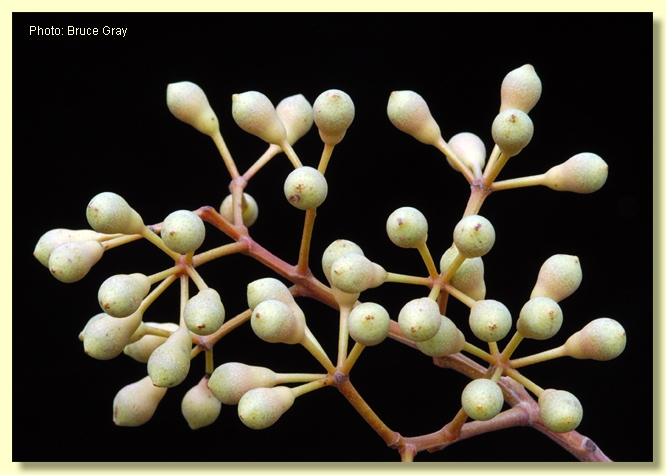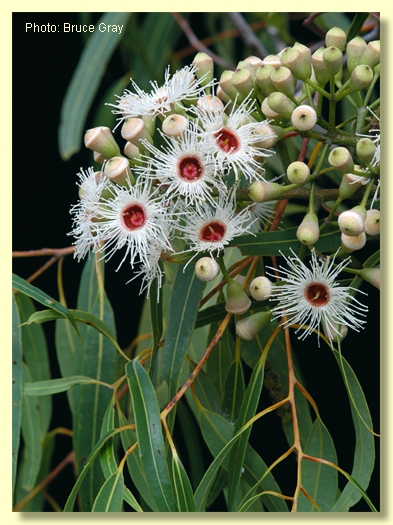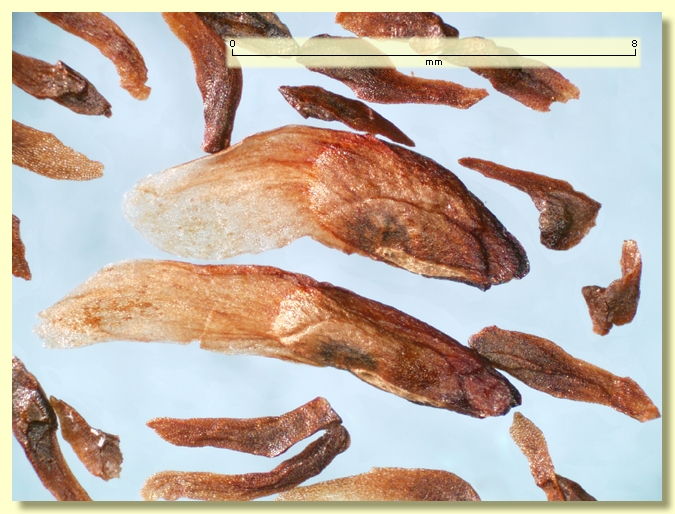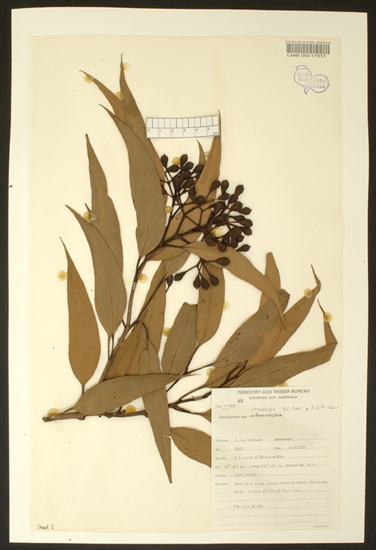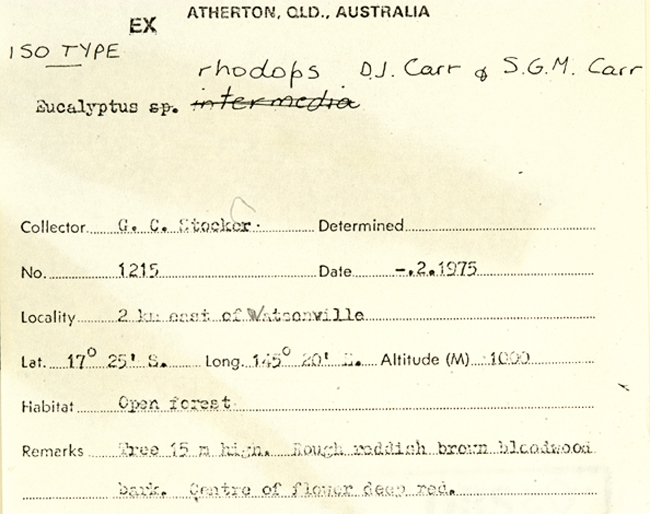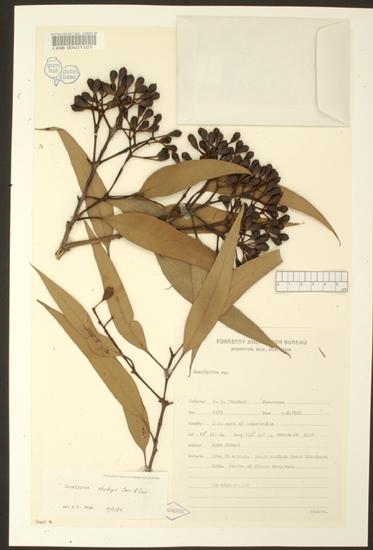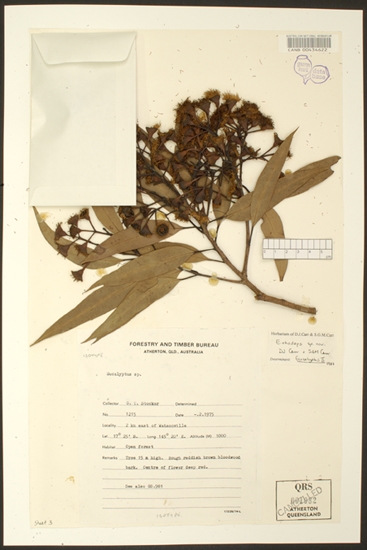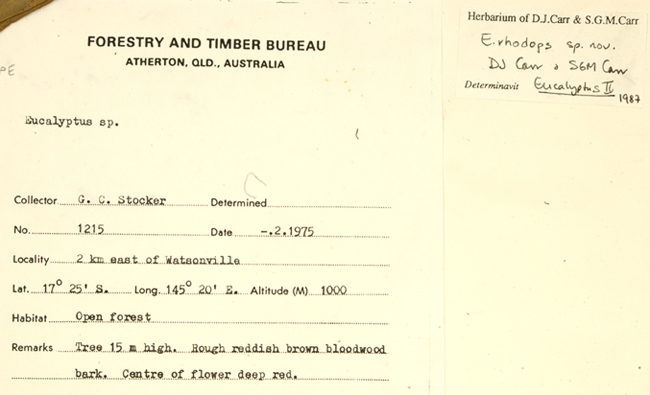Corymbia | Rufaria
Euclid - Online edition
Corymbia rhodops
Corymbia rhodops (D.J.Carr & S.G.M.Carr) K.D.Hill & L.A.S.Johnson, Telopea 6: 276 (1995.
Tree to 15 m tall but often smaller. Forming a lignotuber.
Bark rough and tessellated to branches ca 2–5 cm diameter, rarely only to ca 8 cm diameter, grey-brown to reddish brown.
Branchlets smooth; elongated oil or resin ducts occur in pith.
Juvenile growth (coppice or field seedlings to 50 cm): stem square or angled in cross-section, smooth; juvenile leaves shortly petiolate, opposite for many nodes, elliptic-lanceolate, 4.5–12 cm long, (0.9)1.5–3 cm wide, base tapering to petiole, discolorous, green, glossy above, smooth.
Adult leaves alternate, petiole 0.8–2.5 cm long; blade lanceolate, rarely falcate, 8–15.2 cm long, 0.8–2.5(3) cm wide, base tapering to petiole, margin entire, apex finely drawn out to a point, discolorous, glossy or semi-glossy, green, strongly penniveined, densely to very densely reticulate, intramarginal vein parallel to and just within margin, oil glands obscure.
Inflorescence terminal compound, peduncles angular, 0.4–2.5 cm long, buds 7 per umbel, on slender pedicels (0.4)1–2 cm long. Mature buds pear-shaped to obovoid, 0.8–1.5 cm long, 0.4–0.7 cm wide, smooth, scar absent (both opercula shedding together at flowering), operculum conical to rounded and apiculate or slightly beaked, stamens inflexed, anthers cuboid, versatile, dorsifixed, dehiscing by longitudinal slits (non-confluent), style long, stigma blunt with short papillae, locules 4, the placentae with ovules not arranged in distinct vertical rows. Flowers have creamy white stamens and a red centre (nectary, top of ovary and style).
Fruit pedicellate (pedicels 0.4–2.2 cm long), urceolate to barrel-shaped usually with a conspicuous neck and flared thin rim but sometimes the neck short or obscure, 1.7–2.8 long, 1.2–2 cm wide, disc descending, valves 4, enclosed.
Seeds brown or reddish brown, 7–13 mm long, ellipsoidal with terminal wing, surface smooth, hilum close to one edge, ventral.
Cultivated seedlings (measured at ca node 10): cotyledons large reniform; stems rounded to angled in cross-section, setose for at least 14 nodes; leaves always shortly petiolate (to 0.6 cm), opposite for 14+ pairs, elliptic to oblong-lanceolate, 5.5–14.2 cm long, 1.8–4 cm wide, base rounded to tapering throughout, or sometimes weakly lobed or becoming weakly peltate from ca node 6 to 11, then reverting to rounded, green, discolorous, ± glossy, sparsely setose on both sides at lower nodes, then glabrous above setose below by node 7–10.
Flowering has been recorded in January, February and December.
Bloodwood tree endemic to Queensland occurring only in the area near Irvinebank south-west of the Atherton Tableland, and further north on the Windsor Tableland. It is a species of low open forest on stony hills and ridge-tops in shallow sandy soils. Corymbia rhodops has thick, corky and coarsely tessellated rough bark, a crown of glossy green discolorous leaves, inflorescences terminal on the branchlets, smooth buds, fruit longer than wide and usually with a conspicuous neck and flared rim, and winged seed. When in flower it is striking and unusual with the fringe of creamy white stamens encircling the red centre of the flower. Juvenile leaves are glabrous.
Within its natural range C. rhodops has been confused in the past with C. intermedia, a species usually with a more lowland and coastal distribution, and having slightly smaller fruit on shorter pedicels and creamy white flowers lacking the red centre. Other rough-barked bloodwood species in this general area also have discolorous leaves and smooth buds. They are: C. trachyphloia, which differs in having much smaller fruit (0.5–0.8 cm wide) and wingless seeds; and C. hylandii, C. stockeri and C. nesophila, all of which have smaller fruit than C. rhodops but, like it, have have winged seeds.
C. serendipita also has smooth buds like C. rhodops but has smaller fruit, and much thinner rough bark with reddish hues.
C. rhodops is listed (as Eucalyptus rhodops) as "Vulnerable" under the Australian Government Environment Protection and Biodiversity Conservation Act 1999 (EPBC Act). Further information may be found at this web address:
http://www.environment.gov.au/cgi-bin/sprat/public/sprat.pl
MORE ABOUT CORYMBIA
MORE ABOUT RED BLOODWOODS
Corymbia rhodops: Greek rhod, red and ops, eye, referring to the red-centred wide-open flowers.




